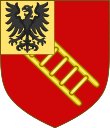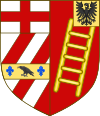Bona family
| (de) Bona Bunić | |
|---|---|
 | |
| Country | Republic of Venice Republic of Ragusa Austria-Hungary |
| Titles | Marquess |
| Cadet branches | House of Giorgi-Bona |
Bona,[1][2] or Bunić,[3] is a noble family long established in the city of Dubrovnik.[4]
History[]
The origins of the family remain largely unclear, but according to the two oldest traditions, it originated from Kotor in Venetian Albania, or else from the town of Vieste in Apulia and Leck. The Almanach de Gotha[5] enumerates it among the eleven oldest native families of the Republic of Ragusa,[6][7] and members of the family were still living in the city in the 19th century.[8] The family was influential and wealthy in the Republic, divided into several branches, and combined with other noble families from Dubrovnik by a series of marriages, which in turn gave rise to additional branches of the family. Their nobility was recognised by the Austrian Empire, which granted a member of the family the title of marquess.

The main branch of the family is still in existence, with its principal residence in the United States, but also a secondary residence and several businesses in Dubrovnik.[9]
Notable members[]
- Jan (Giovanni) Junta Bona (15th century), merchant from Venice, owner of Krakow saltworks and several villages in Małopolska.
- Serafin (Saro) Bona (15th century), theologian and writer, the personal adviser of King Matthias Corvinus[10]
- (died 1464), builder and politician
- (1469-1534), writer and poet, ambassador of the Republic to Pope Leo X. A syllogism of his works was published in Rome in 1526.
- Mihael (Miho) Bona (16th century), Latin, and Italian poet
- Ivan Bunić Vučić (1591 or 1592–1658), poet and writer, now recognized as one of the founders of Croatian literature.
- (1635-1678), led the Republic after the disastrous earthquake of 1667, considered "father" of his country. Died a prisoner of the Ottoman[11] rule in Bosnia, a state funeral was decreed in his honour, and a plaque was erected in the hall of the Grand Council of the Republic. Wrote in the Illyrian Herodias, and other compositions in Italian and Latin.
- Đivo Bona (18th century), student of Cardinal Giovanni Battista Tolomei. He was a poet and writer, remembered for translating plays from French into Croatian, as well as several poems of his own.
- (18th century), bishop and writer
- (1669-1717), general, killed in Belgrade
- (1708-1778), lawyer and writer
- Eduard Bona-Bunić (1894–1944), Croatian Home Guard general
- Frano de Bona (1909–1991), recruited as a spy for the Abwehr during the Second World War but turned by the British Secret Intelligence Service (as Agent FREAK) as part of the Double-Cross System.[12]

Coat of arms on the de Bona villa in Dubrovnik
See also[]
References[]
- ^ Age, Marriage, and Politics in Fifteenth Century Ragusa by David Rheubottom. Investigates the relationships between politics, kinship, and marriage in the late medieval city state of Ragusa (present-day Dubrovnik). At its heart is a reconsideration of `office' and the ways in which ties of kinship and marriage were mobilised to build electoral success.
- ^ The Factions within the Ragusan Patriciate (17th–18th Century) by Stjepan Ćosić and Nenad Vekarić. Table 1. Factions in the Great Conspiracy of 1610/12 by senatorship. (See page 23.)
- ^ "Humanizam -hrv. književnost 14. i 15. st". Archived from the original on 2011-07-21. Retrieved 2010-01-26.
- ^ Notizie Istorico-Critiche Sulle Antichita: Storia e Letteratura de Ragusei by Francesco Maria Appendini. Ragusa Patrizia Famiglia/Patrician Family DE BONA. page 81.Francesco Maria Appendini history of Dubrovnik and her Republic of Ragusa, a history little known in general, and yet full of important information. He describes in separate chapters its form of government, its church, always attached to the Latin communion, its laws, customs, and manners, its relations with Venice and with the Slavonian principalities of Bosnia and Croatia. The " Notizie Istorico-critiche sulla Antichita, Storia, e Letteratura de' Ragusei," in two vols. 4to., and also dedicated to the senate of the Republic of Ragusa.
- ^ Almanach de Gotha 1763/1785 bis 1944 by Justus Perthes Verlag
- ^ Ragusan Archives Document: "Speculum Maioris Consilii Rectores", showed 4397 rectors elected between September 1440 to June 1806; 2764, (63 %) were from eleven "old patrician" families: Gozze, de Bona, de Caboga, Cerva, de Ghetaldi,de Giorgi(slavic Juric/Jurici), Gradi, Pozza, Saraca, Sorgo and Zamanya. A list of Ragusa's governing bodies in 1802 showed 3 that 6 of the 8 Minor Council, and 15 of 20 Grand Council members were from the same 11 families.
- ^ Helias and Blasius De Radoano: Ragusa Merchants in the Second Half of the 14th Century by Barisa Krekic." In February 1378 Blasius and ser Lucas de Bona had appointed two Venetians and a Ragusan" page 408
- ^ Dubrovnik Under French Rule (1810–1814) by Stjepan Cosic/ hrcak.srce.hr/file/12648. "Court of First Instance in Dubrovnik, over which Niko Pozza presided.In Dubrovnik, Ston, and Cavtat, Ivan Bona, Frano Liepopilli, and Nikola Facenda operated as justices of the peace" (page 113).
- ^ "DeBona.com". Archived from the original on 2009-04-27. Retrieved 2010-01-27.
- ^ Pregled Hrvatske Znanstvene Baštine by Vladimir Bazala
- ^ Yugoslavia by Lovett Fielding Edwards. pages 131, 132 & 264. Shortly afterward, the grand vezir, Kara Mustafa, began to prepare an army ... two Nikola Bona died of fever when with the Turkish armies in the Dobrudja.
- ^ [1] Ben Macintyre Double Cross: The True Story of The D-Day Spies
Sources[]
- Francesco Maria Appendini, Notizie istorico-critiche sulle antichità storia e letteratura de' Ragusei, Dalle stampe di Antonio Martecchini, Ragusa 1803
- Renzo de' Vidovich, Albo d'Oro delle famiglie nobili patrizie e illustri nel Regno di Dalmazia, Fondazione Scientifico Culturale Rustia Traine, Trieste 2004
- , Dizionario biografico degli uomini illustri della Dalmazia, Vienna-Zara 1836
- , La libera e sovrana Repubblica di Ragusa 634–1814, Volpe Editore, Roma 1981
- Robin Harris, Dubrovnik, A History, ISBN 978-0-86356-959-3
- Konstantin Jireček, L’eredità di Roma nelle città della Dalmazia durante il medioevo, 3 voll., AMSD, Roma 1984–1986
- Ragusan noble families

